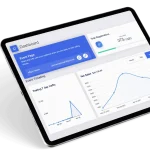
Trade shows provide endless possibilities for every business; however, how can they maximise the benefits they gain from a trade show?
The ability to correctly assign KPIs linked to your show goals cannot only help you assess cost and ROI, but it also allows you to benchmark against competitors, while enabling you to assess show strengths and weaknesses, and plan future shows.
Prepare Your Exhibit
You need a sound principal is essential approach to developing and planning your exhibit. Engage an exhibit house that understands your marketing objectives and can develop an approach to maximise ROI. Make sure your team is in alignment on the quantifiable objectives you hope to achieve at a tradeshow, such as how many leads you plan to scan or how many meetings you plan to have. Announce the show to prospects via a pre-show marketing channel – email, social media, ads or any other outlet they’re likely to see. The timing of your event coincides with the rhythm of your market. If you like trade shows but always attend the wrong one, drive some ROI with local events or invest in a specific show. Measure closed-loop post-show ROI through conversion-rate metric, time to customer, etc.
Plan Your Marketing Campaign
Second, ensure you have realistic expectations going in. Before you arrive at an event, set goals, budgets and time frames for success. For example, if you go to an event with the intent to generate leads, that’s measurable. Set a goal – say, we’re going to get three leads – and then you can judge at the end of the show whether or not it was worthwhile. a well-planned install with training on-site provides in our experience the greatest value. Pre-show marketing efforts can help create buzz about the prizes, demos or special deals your booth will feature. This promotional content can also be shared on social media channels. The more attendance is hyped, the more people will attend. Finally, after an event, attendees become leads, and the sales funnel begins. A brand can continue to build rapport after an event by sending a thank you email to attendee follow up, offering them spec sheets of products downloads or asking if there are any questions they have for the reps.
Develop a Follow-Up Strategy
To use meaningful metrics when tracking trade show ROI, you need to be sure they are S.M.A.R.T.-specific, measurable, attainable, relevant and time-bound. These measurements will help you understand what is being accomplished, and might give you the opportunity to adjust your plans in order to meet your goals. spending your time following up with new leads is the most surefire way to encourage leads to turn into investments is spending your time following up with new leads. While it might be tempting to send out automated follow up emails, take the time to craft an individual follow up email, as it increases the likelihood they’ll come back. Furthermore, these close relationships encourage conversions. If you have a lead with an appointment, then put a link to the scheduling tool directly into the email with the ability for them to ‘book a call when it works for you’. Include other content for them to keep learning about that interest area – or you could invite them to a webinar. All of these things keep your new contacts from falling into a vacuum after they attend your show.
Create a Post-Show Report
Generating an actionable post-show report is very important to help a business understand how successfully they reached their business objectives at a show, and also identify learnings from the event for future exhibitions. Therefore, a good post-show report exemplifies a summary of KPIs which resonates with business objectives, such as expenses breakdown and revenue stream management, including but not limited to expenses for renting a booth, travel and accommodation, sales of collaterals they might produce on site, renting booth at show etc. The direct ROI is very easy to calculate because its results are visible. For instance, a long sales cycle could translate to weeks or months before measurable revenue from a trade show activity can be seen. But to conduct an accurate analysis of KPIs, you’ll need to put in place a data-capture system to source the data, such as online forms for people to complete, which when saved will add a new contact directly into CRM software as being off the back of the show.






